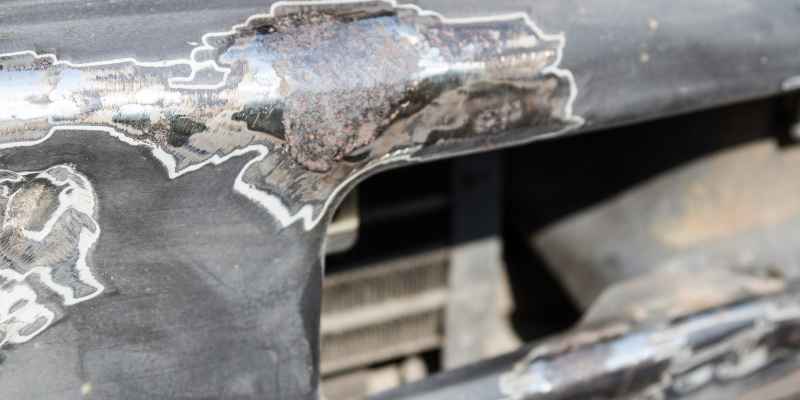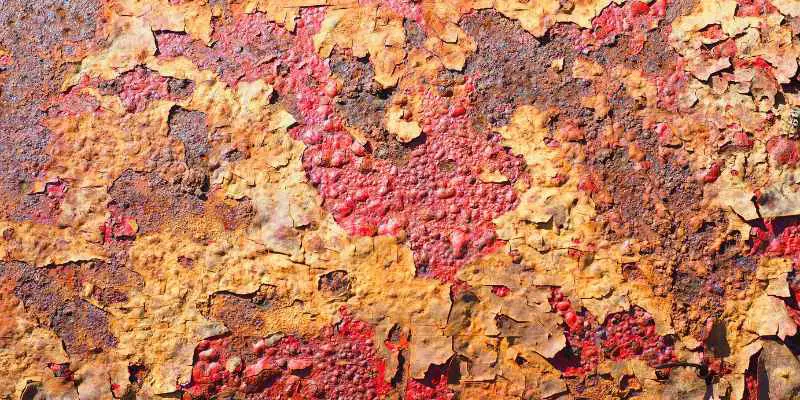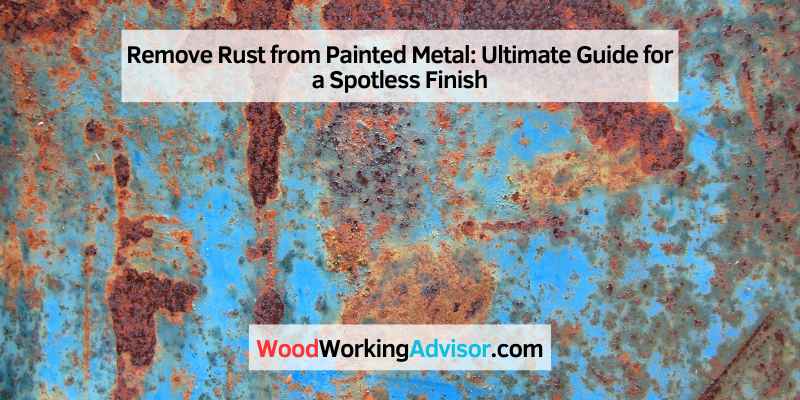To remove rust from painted metal, you need to first clean the surface thoroughly and then apply a rust-inhibiting primer. Rust can be a frustrating issue that can damage the appearance and integrity of painted metal surfaces.
If left untreated, rust can continue to spread and cause further damage. Fortunately, there are effective ways to remove rust and restore the metal’s original condition. We will discuss the step-by-step process of removing rust from painted metal. By following these simple instructions, you can eliminate rust and prevent further corrosion, prolonging the lifespan of your painted metal surfaces.
Whether it’s a car, furniture, or household item, this guide will help you get rid of rust and restore your metal surfaces to their former glory.
Preparation
Rust on painted metal can be an unsightly and damaging problem. However, with the right tools, materials, and safety precautions, you can effectively remove rust and restore the surface to its former glory. In this section, we will explore the necessary steps and precautions you should take before starting the rust removal process.
Gathering Necessary Tools And Materials
Proper preparation begins with gathering the tools and materials you will need for the rust removal process. By having everything ready, you can work efficiently and effectively to remove the rust from the painted metal. Here are the essential tools and materials:
| Tools | Materials |
|---|---|
| Wire brush | Rust remover solution |
| Sandpaper or sanding block | Protective goggles |
| Painter’s tape | Rubber gloves |
| Clean cloth | Drop cloth or plastic sheeting |
Safety Precautions Before Starting The Process
Prioritizing safety is crucial before you begin removing rust from painted metal. By following these safety precautions, you can protect yourself and prevent any mishaps:
- Wear protective goggles and rubber gloves to shield your eyes and hands from chemicals and debris.
- Ensure you are working in a well-ventilated area or wear a respirator if necessary to avoid inhaling any harmful fumes.
- Protect the surrounding environment by laying down a drop cloth or plastic sheeting to catch any loose rust or chemical spills.
- Use painter’s tape to cover any adjacent areas that you don’t want to expose to the rust remover solution or potential scratches.
With the right tools and safety precautions in place, you are now ready to take on the rust removal process. The next section will guide you through the step-by-step instructions to effectively remove rust from painted metal.

Methods For Rust Removal
When dealing with rust on painted metal, it’s essential to use the right methods for effective removal. From chemical rust removers to mechanical techniques, there are various approaches to consider. Let’s explore these methods in detail:
Chemical Rust Removers
Chemical rust removers are formulated to dissolve and neutralize rust, making them a popular choice for removing rust from painted metal surfaces. These products typically contain phosphoric acid, oxalic acid, or citric acid, which work to break down the iron oxide and facilitate its removal.
When using chemical rust removers, it’s important to follow the manufacturer’s instructions carefully to ensure safe and effective application. Begin by applying the solution to the rusted areas and allowing it to penetrate for the specified duration. Afterwards, scrub the area with a brush or scouring pad to loosen the rust, then rinse and dry the surface thoroughly.
Mechanical Methods For Rust Removal
Mechanical methods involve physically removing rust from the painted metal surface. These techniques are ideal for addressing stubborn or heavily corroded areas where chemical treatments may not be sufficient.
- Wire brushes – Using a wire brush is a simple and effective way to remove surface rust from painted metal. The bristles help to loosen and scrape away the rust, revealing a cleaner surface underneath.
- Sanding – Sanding the rusted areas with coarse sandpaper or a sanding wheel can effectively eliminate surface rust and create a smooth, paint-ready surface.
- Grinding – For more severe rust, a grinding wheel or rotary tool equipped with a grinding attachment can be used to aggressively remove rust and corrosion from the metal surface.
Diy Vs. Professional Services
When dealing with rust on painted metal, you may be torn between tackling the problem yourself or seeking the help of professional rust removal services. Both options have their pros and cons.
Pros And Cons Of Removing Rust Yourself
- Cost-Effective: Doing it yourself can save money on service fees.
- Hands-On Experience: You get the satisfaction of accomplishing a task on your own.
- Time Consuming: DIY rust removal can be a labor-intensive process, taking up valuable time.
- Limited Resources: You may lack the specialized equipment and products required for effective rust removal.
- Risk of Damage: There is a risk of damaging the paint or underlying metal surface during DIY attempts.
Benefits Of Hiring Professional Rust Removal Services
- Expertise: Professional services offer the skill and expertise required for thorough rust removal.
- Time-Saving: Professional removal services can complete the job efficiently, saving you time and effort.
- Advanced Tools and Techniques: Professionals have access to specialized tools and techniques for effective rust removal.
- Prolonged Protection: Professional treatment can provide long-term protection against future rust formation.
- Reduced Risk: By opting for professional services, you minimize the risk of causing damage to the painted metal.

Protecting Metal After Rust Removal
After removing rust from painted metal, it’s important to protect the surface to prevent future corrosion. Applying a rust-inhibiting primer or a rust-resistant paint can help seal the metal and provide long-lasting protection. Additionally, using a clear coat or wax can further safeguard the metal from environmental elements.
Primimg The Surface
After successfully removing rust from painted metal, it is crucial to take the necessary steps to protect the metal from rusting again in the future. One important step in this process is priming the surface. A high-quality primer creates a barrier between the metal surface and the elements, preventing rust from redeveloping. Applying a primer is as simple as painting it onto the cleaned metal surface. Allow the primer to dry completely before moving on to the next step. Additionally, make sure to choose a primer specifically designed for metal surfaces to ensure optimal protection.
Choosing The Right Paint For Long-term Protection
Selecting the right paint for long-term protection is essential to keep rust at bay and maintain the appearance of the painted metal. When selecting a paint, consider opting for one with rust-inhibiting properties. These types of paints are specifically formulated to provide a protective coating that prevents rust from developing again. Additionally, it is best to use an oil-based paint for metal surfaces, as it has superior durability and adherence properties compared to latex-based paints. Oil-based paints create a hard, water-resistant surface that can withstand various weather conditions, ensuring long-lasting protection against rust.
In conclusion, protecting metal after rust removal involves priming the surface and selecting the right paint for long-term protection. By following these steps, you can safeguard your painted metal from rusting again in the future and enjoy its aesthetic appeal for years to come. Remember to always use products specifically designed for metal surfaces to ensure optimal protection against rust.
Maintenance Tips For Rust Prevention
Prevent rust from damaging painted metal with these essential maintenance tips. Keep the metal clean, dry and well-protected to avoid corrosion and extend the life of your surfaces. Regularly inspect for any signs of rust and promptly remove it to maintain the integrity of the paintwork.
Regular Inspections
Regularly inspect painted metal surfaces for signs of rust formation to address issues promptly.
Applying Protective Coatings
Applying protective coatings on painted metal surfaces helps prevent rust by creating a barrier.
Regularly inspect painted metal surfaces for signs of rust formation to address issues promptly.
Applying protective coatings on painted metal surfaces helps prevent rust by creating a barrier.
Common Mistakes To Avoid
Skip Surface Preparation Steps
Skipping critical surface preparation steps can hinder the rust removal process.
Use Improper Rust Removal Techniques
Improper techniques like using harsh chemicals can damage the painted metal.
Frequently Asked Questions For Remove Rust From Painted Metal
How Can I Remove Rust From Painted Metal?
To remove rust from painted metal, start by sanding the affected area with fine-grit sandpaper. Then, use a rust converter to neutralize the rust and apply a touch-up paint to restore the appearance of the metal surface.
What Are The Best Rust Removal Methods For Painted Metal?
The best rust removal methods for painted metal include using a wire brush or sandpaper to remove loose rust, applying a rust converter to stop the spread of rust, and using touch-up paint to restore the metal’s appearance.
Can I Use Household Items To Remove Rust From Painted Metal?
Yes, you can use household items like vinegar or baking soda to remove surface rust from painted metal. Simply create a paste with the household item and apply it to the rusted area, then scrub gently with a cloth or brush.
Is It Necessary To Repaint The Metal After Removing Rust?
Yes, it is necessary to repaint the metal after removing rust to protect it from further corrosion. Applying a fresh coat of paint not only improves the appearance of the metal but also acts as a protective barrier against rust formation.
Conclusion
To restore the beauty of your painted metal surfaces, it is essential to effectively remove rust. By following the expert tips discussed in this blog post, you can successfully eliminate rust and extend the life of your metal objects. Remember to clean the surface, brush off loose rust, apply a rust remover solution, and protect the metal with a primer or paint.
With these simple steps, you’ll achieve a rust-free and visually appealing finish. So, bid farewell to unsightly rust and enjoy the restored charm of your painted metal!


